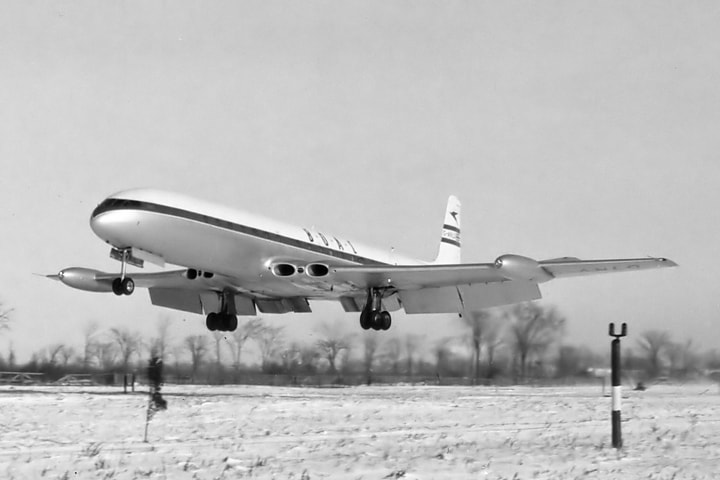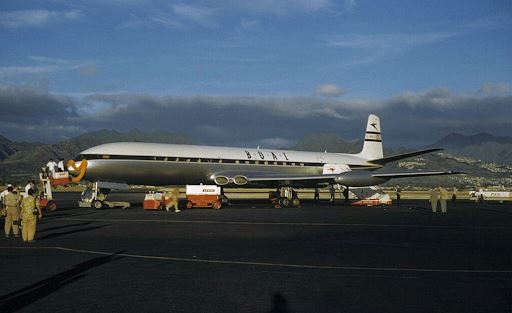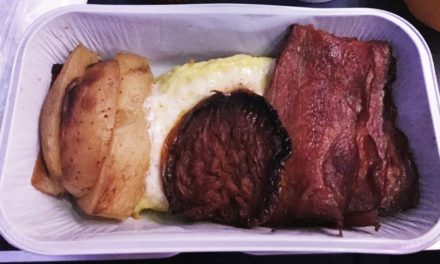The initial success of the de Havilland Comet 1 made airlines everywhere sit up and take notice. As the world’s first jet airliner, it slashed flying times on any route it serviced and passengers loved the new smooth vibration free flight.
At the time, Pan Am was one of the most highly regarded airlines in the world. One of their major competitors on the transatlantic routes was BOAC, so they also decided to get in on the act.
Pan Am Orders The Comet
In October 1952, just five months after the Comet entered airline service, Pan Am placed an order for the British jet. This “surprised and dismayed the American aircraft industry” according to an article in Time Magazine published on Monday, 27 October of that year.
The United States, at the time, had no jet airliner ready for production at all. Even the Boeing 707 prototype, the Boeing 367-80, did not fly until 15 July 1954.
- The Comet 3 on a promotional tour.
Pan Am ordered the forthcoming de Havilland Comet 3. This was a 4.7 metre (15 feet, 5 inch) stretch of the baseline aircraft, powered by the more powerful Rolls-Royce Avon 502 engine, and with pinion fuel tanks to increase range up to 4,345km (2,700 miles) non-stop.
As Juan Trippe put it, it allowed the jet, “to operate efficiently over the principal routes of Pan American.” They placed three firm orders and seven options for an estimated cost of US$6,300,000. Deliveries were to commence in 1956 and the options, if exercised, were for 1957 delivery slots.
What Happened?
Unfortunately for de Havilland and the British aircraft industry, the initial Comet 1 had a design flaw. Metal fatigue was not as well understood at the time for planes operating at the high altitudes of the new jet. There were three high profile crashes, and the investigation revealed shortcomings in the aircraft’s design.
- The sleek lines of the single Comet 3 are very evident here.
This meant only one de Havilland Comet 3 was built, before the new, improved and safer Comet 4 arrived in 1958. During this time, the US aviation industry had come up with the Boeing 707 and Douglas DC-8, followed by the Convair 880 and Convair 990, so there was no longer any need for the outdated Comet.
Overall Thoughts
It is a shame Pan Am never operated the de Havilland Comet. For the British, it would have been a real coup to have a blue chip US airline operating their new jet.
Either way, the jet age was ushered in by the Comet. The lessons learned from that cutting edge design were shared with other manufacturers to ensure the metal fatigue problems did not occur in the same way again.
Did you know that Pan Am ordered the de Havilland Comet? Did you ever manage to fly on a Comet 1 or Comet 4? Thank you for reading and if you have any comments or questions, please leave them below.
Like planes? See my “Does anyone remember” series.
Flight reviews your thing? Mine are all indexed here.
Follow me on Facebook, Twitter and Instagram.
Featured image via Canadian Aviation Historical Society.
Other images via This Day In Aviation.







I knew that Pan American ordered the Comet. I believe that Mexicana de Aviacion’s Comet IVs came from Pan American. I flew as a passenger aboard Comet IVs of Olympic Airways (IST-ATH-FCO) Sudan Airways (NBO-KRT-CAI) and Mexicana de Aviacion (LAX-MEX-MID-MBJ) in the 1960s.
Pan Am ordered the Comet but they were never built. Mexicana ordered the Comet 4 in their own right, so they weren’t from Pan Am. Nice that you got to fly on the aircraft though! I’ve only been on board one in a museum in Scotland. Thanks for sharing that!
Interesting. I still can’t get over what a gorgeous plane that is.
It certainly has it in the looks department, that’s for sure!!
Way too young to have flown on Comet. I have been inside one at a museum
Same here, on both counts! It’s not a particularly large aircraft inside, that’s for sure!